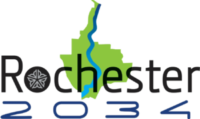THE PLACEMAKING PLAN

Overview Of The Placemaking Plan
Comprehensive plans typically contain a future land use plan as the centerpiece for guiding physical change in the municipality. The community engagement process for Rochester 2034 made it abundantly clear that there are many other elements – physical projects, policies, and programs – that intersect with land use and development to contribute to a functional cityscape and positive sense of place. As such, this comprehensive plan contains an innovative approach to conventional land use planning by integrating these other elements into a larger Placemaking Plan.

Future Land Use
Comprehensive plans traditionally have a future land use plan which is a geographic vision for how land uses and urban form should change and be preserved over time. In legacy industrial cities, the future land use plan is typically designed to promote redevelopment, redensification, and historic preservation. Land use planning in an urban setting requires a strategic blend of orderly growth, organic flexibility, and preservation of neighborhood and natural assets. The Placemaking Plan attempts to strike that balance. It presents a vision for land use and development according to “Character Areas”, which are the land use recommendation that will be used to inform a new zoning map and code.

Other Placemaking Elements
The Rochester 2034 approach to land use planning goes beyond directing the location and design of future development. It also examines a series of interrelated physical and programmatic elements. Some are location-specific such as bicycle facilities, park improvements, infrastructure, and access to the Genesee River. Others are city-wide in nature, such as options for reusing vacant lands, programming public spaces, supporting public art, and rethinking parking policies. Recommendations for each of these categories can be found on the Placemaking Plan Map and throughout the Action Plan.
